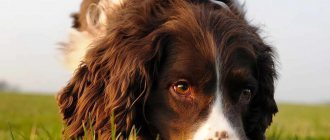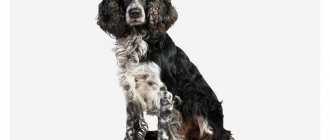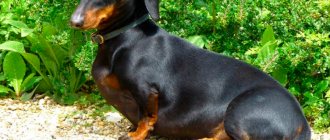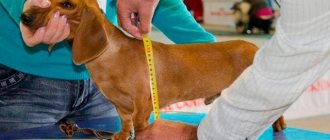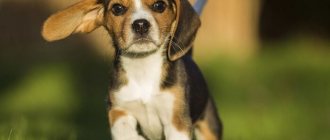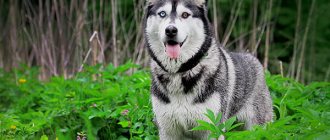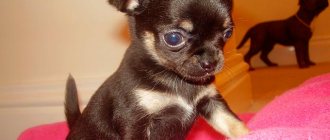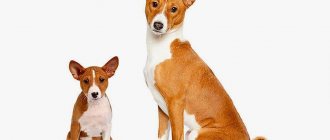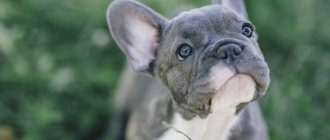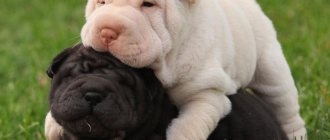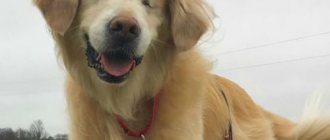Breed traits
Breed traits (on a 5-point scale)
| Beagle | |||
| Activity | in the house | 3 | |
| on the street | 4.3 | ||
| Obedience | training | 2.9 | |
| strangers | 3.2 | ||
| Domination | in family | 2 | |
| over dogs | 2.3 | ||
| Defending your territory | from people | 1.8 | |
| from dogs | 2 | ||
| Sociability | in family | 4.6 | |
| with strangers | 3.9 | ||
| with dogs | 3.9 | ||
| Concentration | in family | 1.4 | |
| in front of strangers | 1.8 | ||
| with dogs | 1.9 | ||
| Aggressiveness | in family | 1.1 | |
| to strangers | 1.4 | ||
| to the dogs | 1.8 | ||
| to cats | 2.1 | ||
| Family behavior | calmness | 3.3 | |
| demand for affection | 4.2 | ||
| excitability | 3.7 | ||
| playfulness | 4.3 | ||
| excessive barking | 2.5 | ||
| behavioral breakdowns | 2.2 | ||
| Tolerance for children | up to 4 years | 4 | |
| over 4 years old | 4.4 | ||
| Institutional use | watchman | 3.3 | |
| bodyguard | 1.4 | ||
This breed is often compared to the following dog breeds: Jack Russell Terrier, Labrador Retriever, English Cocker Spaniel, Cardigan Welsh Corgi, French Bulldog.
You can see what Beagle dogs look like from the photo:
Appearance
Muzzle
Diseases of the breed and life expectancy
The average lifespan of an animal with proper care is 13–14 years. Representatives of the Beagle breed may suffer from the following ailments:
- Epilepsy.
- Hypothyroidism.
- Obesity.
- Glaucoma.
The beagle's heavy, floppy ears interfere with the ventilation of the ear canal. The consequence of this may be the development of various infectious diseases. In the absence of medical care, the animal may develop otitis media and meningitis. Your dog's ears should be examined daily. If necessary, they need to be cleaned and treated with special lotions.
Some animals develop herniated discs over time. The dog begins to experience severe pain and loses interest in active life. The hernia is treated surgically.
Beagle: general characteristics of the breed
Along with Fox Terriers and Jack Russell Terriers, Beagles are small hounds. They were used for hunting hares and followed the scent well thanks to their sensitive sense of smell. These dogs have been popular for hundreds of years. At first they were used for hunting, now they are a cheerful, loyal pet, an ideal companion for an active person of any age.
Beagles are energetic, good-natured, and loyal. This is a cheerful, cheerful dog that infects others with its optimism. Beagles have no aggression at all, they are friendly even with strangers, and get along well with children. Due to its charming appearance and small size, this is one of the most popular breeds for keeping in a city apartment.
The main characteristics of these dogs can be found in the table.
| Parameter | Characteristic |
| Weight | Females 7-10 kg, males 10-13 kg |
| Height | Females 33-40 cm, males 35-45 cm |
| Lifespan | 13-15 years old |
| Aggressiveness | Low |
| Intelligence | Smart, witty, inquisitive |
| Working qualities | Hunting, good sense of smell, cannot be a guard or protector due to friendliness |
| Activity | Very high |
| Training | Smart, but stubborn and headstrong |
| Aggressiveness | Low |
| Need for care | Light, moderate shedding |
| Friendliness | Tall, very fond of children, friendly with other dogs |
| Attitude towards loneliness | Can't stand it, love communication |
pros
Beagles have many advantages. These are cute, funny pets, friendly and cheerful. They will not let you get bored and will support the owner in any activity. The popularity is also explained by the following advantages:
- not aggressive;
- love children;
- loyal to the owner;
- very sociable, friendly with everyone;
- hardy and energetic;
- clean, easy to care for;
- no drooling, no unpleasant odor;
- good scent.
The photos show what active, positive dogs they are:
Ball game
Jumping
Minuses
But before you get a representative of this breed, you need to take into account that it has disadvantages. According to owner reviews, the following disadvantages can be noted:
- high physical activity required;
- cannot stand loneliness;
- very noisy, love to bark;
- stubborn, cunning;
- easily distracted, difficult to train;
- adult dogs are independent and freedom-loving;
- are not capable of becoming a security guard or watchman;
- because of their hunting qualities they love to dig holes;
- may run away if attracted by a smell or small animal;
- tend to be overweight.
The main disadvantage is that without strict upbringing they strive to take a leading position in the family and become uncontrollable. You shouldn't get a beagle if you can't exercise it.
Interesting facts about the Beagle breed
Beagles are very popular dogs that have served humans for a long time. There is a lot of interesting things to tell about them:
- Beagles have 225 million olfactory receptors;
- they are used to search for drugs, weapons, contraband, and explosives;
- often appear in films, and the cartoon about Snoopy, a small beagle, is popular all over the world;
- without physical activity and communication, they become very bored, their behavior can become destructive;
- they are often stolen by criminals and sold for medical experiments, as they are calm and hardy;
- Charles Darwin traveled on a ship called the Beagle.
The video will tell you about the pros and cons of the breed:
Video: Pros and cons of the breed
Rules for choosing a puppy
Becoming the owner of the Beagle breed is not difficult. The main thing is to want it. The issue of choosing a puppy must be approached responsibly. It all starts with meeting the parents of the future pet. Many qualities of a puppy are inherited. The beagle should come on its own. This way the puppy will demonstrate curiosity and friendliness.
You can take a dog away from its mother at 2 months. The Beagle will quickly fit into the family charter. When choosing an older puppy, you will have to deal with excessive curiosity. The pet will try to find weaknesses in the family structure.
Because of its friendliness, Beagles can be adopted into adulthood. The main thing is to get along in character.
History of the origin of the Beagle breed
There are two versions of the origin of beagles. According to one of them, the ancestors of these dogs were brought to England from the Roman Empire and began to cross with local breeds. But there is evidence of the existence of small hounds in the British Isles even before the arrival of the Romans. This is an ancient breed, used by people for hunting for over a thousand years.
In the 13th century, small hounds called beagles became popular among aristocrats. They were called Glove Beagles. Then these dogs were miniature, no more than 25 cm, lived in the house and were used for fun. Gradually they gained popularity among farmers and began to be used for baiting hares. After all, a small hound could pursue prey in the undergrowth where a large dog could not get through.
By the 15th century, the name beagle appeared, which translated meant “small”. These dogs were crossed with other breeds to improve their working qualities. Back then they had an unattractive appearance, but speed and scent were more important to hunters. By the end of the 17th century, the popularity of beagles began to decline as fox hunting spread. The breed was preserved by simple farmers.
Breeder Philip Honeywood began breeding in the mid-19th century. He paid a lot of attention to external data. It was from this time that we can talk about the appearance of modern beagles. They spread throughout the world, and clubs for breed lovers began to be created.
How long do beagles live?
If you look at the breed standards, it becomes clear that the average lifespan of beagles is 12-14 years. The British hound can be classified as a dog that can live for quite a long time, which is what its owners like.
Although purebred dogs can live a long time, there are factors that lead to their early death, including:
- delayed veterinary care;
- poisoning with pesticides;
- injuries received during hunting or road accidents;
- infectious diseases;
- late or incomplete vaccination;
- the presence of parasites in the dog’s body;
- poor nutrition;
- genetic pathologies.
To find out how long a beagle lives, you need to understand what factors can affect the life of an animal. Females can live much longer, since fewer males suffer from ailments of the nervous, genitourinary and musculoskeletal systems, thyroid gland, and gastrointestinal tract. At the same time, they suffer from the formation of cysts in the ovaries, hypothyroidism, dermatitis, and food allergies. Labor can reduce the development of cancerous tumors or cysts in the ovarian area. Neutered individuals will live 24-36 months longer, but may gain significant body weight. That is why the owner will have to adjust the pet’s menu, reducing the amount of protein, fat, and carbohydrates.
The fact that the dog lives for such a long time allows families with small children to safely adopt it. Parents who decide to buy a beagle do not have to worry that the aging and rapid death of the pet will cause trauma to the little owner.
Description of appearance
The Beagle breed was officially recognized at the end of the 19th century. But the modern standard was adopted in the 50s of the 20th century. It is a medium-sized dog with strong muscles and short, thick hair. According to the standard, the height of a beagle at the withers is from 33 to 40 cm, weight is 8-16 kg.
Head
The beagle's head is proportional in size and dome-shaped. The forehead is convex, the stop is clearly visible, the occipital protuberance protrudes slightly. The muzzle is elongated and of medium size. Bitches have a narrower one. The nose is wide and black. The skin does not gather in folds, but the lips do not fit tightly, due to which they form small jowls. The jaws are strong and have a scissor bite.
The eyes are large, widely spaced, and brown in color. Very expressive and smart. The ears are set slightly higher than the eyes, hanging. They are wide, rounded at the bottom. The leading edge is adjacent to the cheeks.
From the photo you can see what kind of head and muzzle the beagle has:
Head
Muzzle
Puppy
Torso
The physique is strong and muscular. The neck is of medium length, the chest is wide, the stomach is tucked. The back and lower back are level, and the croup is moderately sloping. The tail is set high and not very long. It is thick and covered with thick fur. The dog most often holds it almost vertically, without throwing it over its back.
Limbs
Limbs are straight, parallel, muscular. Thanks to this, the dog’s movements are smooth, fast, and free. The paws are compact, strong, with arched toes.
Wool
The coat is thick, short and smooth, with no undercoat. It fits tightly to the body, so it does not allow water to pass through and protects the dog well from bad weather. The classic color is three colors: black, white and red. There are white and red dogs. Lemon-white, white with red and blue, motley and hare colors are acceptable. The chest, muzzle stripe and tip of the tail are always white.
Deviations from the standard
There are several appearance defects due to which a dog may be rejected and not allowed to participate in the exhibition:
- short stature;
- small or very bulging eyes;
- an unpronounced stop on the muzzle or a very noticeable occipital protuberance;
- undeveloped muscles;
- pointed muzzle;
- light eyes;
- depigmentation of the nose.
Varieties
Since the 19th century, Beagle dogs have spread throughout the world and become popular. Therefore, breeding in different countries proceeded in parallel. Now, in addition to the classic beagles, there are three varieties:
- American ones have thick hair;
- French ones were obtained by crossing with a Harrier, they are larger;
- Irish ones reach a height of 55 cm and are called Kerry Beagles.
From the photo you can get acquainted with the appearance features of the representatives of the breed:
Playing with a stick
Appearance
What varieties are there?
There are several subspecies of the breed - American and European.
The European subspecies include:
- French Beagle Harrier. A hound from France, obtained by crossing a beagle and a harrier. Weight up to 20 kg, height at withers – 38-48 cm;
- Irish Kerry Beagle . Dogs bred in Ireland in the 16th century. Their height at the withers is 56-55 cm, and their weight is 20-27 kg.
The American Beagle differs from the English Beagle in having a thicker coat and height reaching 38-41 cm.
Description of the character of the Beagle breed
By nature, the beagle is a cheerful, active and good-natured dog. She is very attached to her owner, loves communication and walks. She is not aggressive and does not get into conflicts with other dogs. But since this is a hound, you need to be careful on the street so that it does not chase a cat or birds.
Beagles love children very much, although due to their good nature they cannot be nannies. But for a teenager, this dog will become the best friend. The beagle is suitable as a pet for active, cheerful people. This breed is not currently used as a hound, but is ideal as a companion.
A description of the character traits of this dog can be found in the video:
Video: Interesting facts
Education and training
Adult beagles are very intelligent, but can be disobedient due to their independent nature. They are cunning and like to have their own way. Only proper upbringing will help you manage your pet. This is a pack dog, so it will quickly learn to obey the one it considers to be an authority.
When training, you need to be persistent and patient. You should not rudely scold or hit this dog. He loves affection and responds well to praise. Training needs to start from an early age. It is important to immediately show the puppy what is possible and what is not; the dog must obey the first time.
It is necessary to accustom him to a place, a leash, and basic commands: “Come to me,” “No,” “Next,” “Sit,” “Lie down.” Beagles are stubborn and cunning and love variety. Therefore, you need to structure your training correctly so that the dog does not get bored.
Education and training
Training a Beagle is not an easy process. The dog is stubborn and can quickly throw its owner out of emotional balance. You need to be patient and systematically train your beagle for 20-30 minutes a day. Correct habits must be instilled in a dog at the age of 5–6 months. It will be difficult to train an adult beagle to be clean and obedient.
The dog must master a series of simple commands (“Fu”, “Lie down”, “Sit”, etc.). In urban conditions, they can save an animal’s life. Beagles often get carried away with exploring other people's tracks and can accidentally jump onto the road. A command given in a stern voice will protect the animal from danger.
The dog must see its owner as a leader, otherwise it will sabotage the educational process. Reinforce your dog's correct actions with treats and praise. Over time, the amount of food needs to be reduced. A properly trained dog should not lunge at people or bite their legs.
Maintenance and care
This breed is ideal for keeping in an apartment. Beagles hardly shed and do not drool. They are odorless and do not require special coat care. But the dog needs regular exercise. Without this, the pet gets bored and can damage things and furniture. This is a hound, so you need to regularly take the dog out of town. Only in nature can she run around to her heart's content and throw out her energy.
In winter, it is worth putting on warm clothes for your dog, as they are sensitive to cold. For the same reason, beagles can only be kept outdoors in an insulated enclosure.
Hygiene
1-2 times a week you need to brush your pet with a natural brush or rubber mitt. During shedding, brush daily with a special comb. It is advisable to bathe beagles rarely, once every 1-2 months, using only hypoallergenic soap. Otherwise, the protective lubricant can be washed off. To maintain cleanliness, you can regularly wipe the coat with a damp cloth, and wash your paws after walks.
Every week you need to wipe your dog’s eyes with a cotton pad soaked in warm boiled water or a special solution. Particular attention should be paid to the ears. They are hanging, so they are prone to inflammation. It is also recommended to brush your pet's teeth every week. If the claws do not grind down on the asphalt, they need to be trimmed.
Nutrition
Beagles are not prone to allergic reactions and are unpretentious in their choice of food. Therefore, they can choose any food. It should be intended for dogs of medium breeds, preferably super-premium class or holistic. Bosch, Orijen, Probalance, Eukanuba foods are suitable.
With natural feeding, 60-70% of the diet should be animal proteins. The rest is porridge and vegetables. You should not give your pet fatty meat, offal, sweets, potatoes, legumes, pickles, or smoked meats. When feeding naturally, not only puppies, but also adult dogs need to be given additional vitamin and mineral complexes.
Health
With proper nutrition and good care, a dog can live a long time without getting sick. This is a hardy breed. The most common problem is the tendency to obesity. Beagles love to eat, so if you don't take care of it and don't give them enough exercise, they will gain weight. There are several other diseases that this breed is prone to:
- hip dysplasia;
- retinal atrophy, glaucoma or cataracts;
- epilepsy;
- intervertebral disc diseases;
- dysfunction of the thyroid gland.
It is important to deworm every three months. And also check the fur for ticks, fleas and other parasites. Special drops or anti-flea collars protect against them well.
Accepted standard
Characteristics of the exterior of beagles according to the generally accepted standard:
- the head is elongated, but not pointed, without folds or wrinkles;
- the stop is well defined, dividing the length of the head from the weakly defined occipital protuberance to the tip of the nose as evenly as possible in half;
- the nose is large, black, the nostrils are wide;
- jaws are strong, scissor bite;
- the ears are long, rounded at the ends, soft, set low, and when stretched out they almost reach the tip of the nose;
- the eyes are large, not protruding, hazel or dark brown in color;
- the tail is of medium length, set high, densely covered with hair, straight, does not bend when moving;
- the back line is straight, the lower back is short, strong and flexible, the stomach is not too tucked, the chest is deep, dropped below the elbows;
- paws are short, straight, set parallel.
The length of the front legs to the elbows should be approximately half the height of the dog at the withers.
How to choose a beagle puppy
It is recommended to buy a beagle puppy from experienced dog breeders or a kennel. You need to study reviews and compare prices. After visiting the breeder, pay attention to the conditions in which the animals are kept, how the mother behaves, and look at the documents. A puppy is purchased when it is 2 months old. He must have:
- correct bite;
- the coat is shiny, smooth, without dandruff and bald patches;
- wet cold nose;
- eyes and ears without discharge;
- the stomach is soft;
- active behavior;
- all age-appropriate vaccinations.
A healthy baby is inquisitive and plays with other puppies. He moves confidently and stands well on strong limbs. The puppy should not be aggressive or cowardly. When choosing a gender, you need to take into account that males are more independent and tend to run away. The girls are affectionate and obedient, but they will have to put up with regular estrus.
The price of a beagle puppy depends on the availability of pedigree, compliance with the standard, and class. A purebred dog can be bought in Moscow for 20-40 thousand rubles. The cost of a female will be a little more expensive. The price of a puppy without a pedigree is about 5 thousand.
The photo shows what a beagle puppy should be like:
Puppy
Puppy
For those who find it difficult to decide whether to get a beagle or not, this video will help:
Video: Features of the breed. Pros and cons
The Beagle is a cheerful, cheerful dog, an ideal pet for active people. The popularity of the breed is explained by its unpretentiousness, small size and lack of aggressiveness. A beagle will become a child's best friend and a companion for lovers of nature walks. With proper upbringing, he will delight the owner with his optimism and charming appearance.
How to find out the age of a pet?
Some beagles end up in another home no longer as puppies, and the new owner often has no idea about the age of the dog. In such cases, it is almost impossible to accurately determine how old the dog is. And the approximate age can be determined by muscle tone and the condition of the coat and eyes:
- The fur of a young animal is shiny. With age it becomes duller and rougher. Beagles begin to turn gray at the age of 6-7 years.
- Puppies and young dogs have clear eyes. Older beagles have a dull look. The eyes of older individuals become cloudy.
- A young and energetic beagle spends a lot of time on the move. That's why he has well-developed muscles. As a dog ages, its activity decreases. Older individuals sleep a lot and walk little. Because of this, their muscles atrophy and obesity appears.
- Milk hooks and fangs erupt on the 20-25th day. The incisors come out by 30-35 days of age. By 1-2 months, the puppy already has a full set of teeth.
- By six months, the Beagle completes replacing its milk teeth with molars. And by 12 months, all the notches are visible on the incisors.
- At 1.5-2 years, the dog’s tooth enamel begins to turn yellow. At the same time, the tubercles on the lower hooks are erased.
- By the age of 4, the enamel becomes matte, and the first problems with the gums appear. Then the jagged edges disappear from the upper hooks.
- By the age of 5, beagles' fangs become dull and the enamel becomes noticeably yellow. At this age, all the irregularities and nicks on the dog’s incisors are erased.
- By the age of 6, it is almost impossible to determine the correct bite of an animal. This is due to a change in the shape of the incisors.
- By the age of 8-10, the dog’s fangs are noticeably shortened and dulled. The teeth wear down and become yellow.
- In older dogs, tartar is clearly visible and there are signs of caries. Teeth become loose and fall out.
You can more accurately determine the age of a dog by the condition of its teeth:
Standard sizes
The Beagle breed standard, approved by the English Club in 1988, has certain requirements for weight, height, proportions and color. Among the main colors of wool, there are options:
- spotted;
- maroon;
- variegated type.
It is based on a combination of two or three colors: white, black and red. The only acceptable solid color is snow-white. Purebred animals are determined by a number of parameters:
- with a wide chest, with the correct location of the lungs and heart;
- with a stocky, athletic build, without excessive bulk or fragility;
- parallel bones of the muzzle;
- long ears - to the end of the nose;
- powerful neck and middle lower back;
- not too short legs against the background of an elongated body;
- long and straight tail;
- developed muscles in the back.
Beagle standards are characterized by:
- athletic build;
- a medium-sized head, a rather large skull and a bump on the back of the head;
- hanging ears, medium-sized tail with a white tip;
- large and non-bulging eyes;
- jaw with a scissor bite, slight sagging lips.
Animals are distinguished by endurance, stubbornness, quick reaction to stimuli, and dexterity. Positive character traits include the ability to make independent decisions, friendliness, and a calm attitude towards children. A lively mind and observation, lack of aggressiveness, and the ability to follow a scent are the best qualities created by long-term selection work.
Important! The size of an adult Beagle dog must comply with the norms of proportionality. Half the height at the withers is the distance from the elbow to the ground.
The slightest deviation is considered a defect and reduces the chances of being eligible to participate in exhibitions. Defects are assessed based on physical and psychological parameters, and the ability to perform the duties of a hound dog.
The difference in size between a baby and an adult dog
Owner reviews (pros and cons)
When choosing a Beagle, people understand the characteristics of this dog breed and are not fooled only by its external attractiveness. Each pet is individual and unique, but there are some features that are characteristic of all representatives of the breed.
Anna, 24 years old
My boyfriend gave me a Beagle puppy last year. The first months were very busy - I had to replace the linoleum in the bedroom twice and replace half of the wardrobe. But we didn’t give up, and after hard work on the site with the dog handler, Edward improved in many ways. Now he is an obedient and very smart baby, my joy and pride!
Yuri, 46 years old
I have been hunting for over twenty years and have worked with different dogs. Now I have two Beagles. I can say that they fulfill the requirements with dignity. The dogs follow the scent well and give voice. But in winter it is difficult to use these dogs in hunting - snow poses a certain difficulty for the Beagle. I don’t see any particular problem with this; I understand that these are the characteristics of the breed. Overall I'm happy with everything.
Valentin, 17 years old
My Lou is a real star of the area! Passers-by always notice him, they often ask him to “take a picture with the dog,” and children love to play with him. And Lou is just happy. He can run around for hours and entertain people. He has many canine friends, and for some reason he has a special love for the huge Dogina. True, Lou almost escaped a couple of times, but everything ended well.
Sveta, 29 years old
My Beagle Vanessa will soon be 16. I remember how I wanted such a dog, how my parents brought her for New Year. From the first days we became best friends! Vanessa immediately established herself as a very clean and affectionate dog. Now she has problems with excess weight and joints due to age, but my girl is still as charming and cheerful as in her youth. She still greets me from work the same way she once did from school, and still enjoys walks. This is the most faithful and kind friend.
How to feed
Beagles are gluttons, this is a breed trait that is compensated by the correct selection of food and upbringing. You need to make sure that your dog gets enough calories and nutrients.
You can feed dry food - Acana, First Choice and other premium foods, in which the main components are meat and bones, and not ground beans and soybeans.
You can feed him natural food, but, of course, not the kind that people eat. The diet includes:
- Meat, and lean meat. They give poultry, veal, beef. They don't serve pork.
- Cartilage for cleaning teeth. Pork ears and legs, beef thigh bone. Small bones, bird bones, hare or rabbit bones, and tubular pork bones should not be given, as this can cause injury.
- Vegetables. Pumpkin, carrots, red and yellow bell peppers are a must - they contain vitamins that strengthen the immune system and have a good effect on health. But beans, cabbage, and potatoes should not be given, they increase gas formation and have a bad effect on the stomach.
- Fruits. Sweet apples, ripe bananas. They give it a little at a time as a treat. They strictly do not give grapes! Citrus fruits are also not allowed, they have a bad effect on the lining of the stomach.
- Porridge. There is slightly less of them in the diet than meat; they contain fiber and carbohydrates, which provide the body with vital energy. Buckwheat and rice, maybe millet. It is not recommended to give pearl barley porridge, lentils, egg and other similar ones. (see what cereals can be given to dogs)
- Dairy products. Cottage cheese and kefir are given in small quantities - they contain calcium, which is very beneficial for bones and teeth. Pure milk is not given because adult animals hardly digest it.
A little vegetable oil is added to the porridge - this allows you to reach the normal level of fat, without which the claws will begin to peel and the coat will suffer. Once a week they give a boiled egg - it also contains fats. You can’t give it more often, because the pancreas will suffer.
Pregnant and lactating bitches, small puppies and older dogs are given vitamin supplements specially developed by veterinarians to their diet. Sick dogs who suffer from gastrointestinal problems, diabetes, kidney and liver failure are kept on a diet of special food, since it is very difficult to choose a natural diet.
It is important to calculate the amount of food correctly. The daily allowance is written on the food packets. Natural food should not be more than 3% of the dog’s weight. That is, a teenage beagle weighing 10 kg should receive 300 g of food and no more.
In order to definitely prevent the development of obesity, these 300g also include the treats that the dog will receive during exercise and training commands.
And to make sure he gets everything he needs, when choosing a diet, consult a veterinarian.
Features of character and behavior
Advantages
- Beagles are very inquisitive and cheerful. They like to explore every corner of the house and yard and show genuine interest in everything new and exciting. They stick their wet nose into everything going on around them, which is why they cause affection and amusement to their owners.
- This dog is very accommodating, sociable, and friendly. Gets along well with other animals and becomes a loyal friend to children. As a rule, he takes part in all active outdoor games with pleasure, brings sticks, balls, and plays catch. It is not aggressive, has strong loyalty and affection for its owner, does not exhibit dominant qualities, but on the contrary is inclined to submit to both adults and children.
- The dogs are active and mobile. Moreover, long games in the fresh air are essential for these dogs. Owning a beagle would be an ideal option for athletes and restless people. This little friend will support any walk, you can take him with you for jogging, outdoor sports, and his strong body with well-developed muscles gives the dog endurance and will allow him not to get tired for a long time.
Flaws
The disadvantages of the breed include the following features:
- Slightly awkward linear movements;
- The animal's tendency to overeat;
- Arrogance and difficulty in training;
- Small weak teeth;
- A drooping or, conversely, sharply tucked belly;
- Shyness of character, inability to defend.
